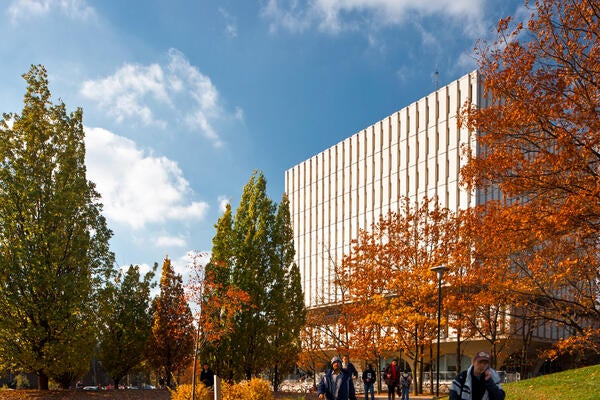
Waterloo researcher discovers sustainable way to protect crops from drought and disease.
Bernard Glick presents his findings this week at the annual meeting of the American Association for the Advancement of Science (AAAS) in Boston.

Bernard Glick presents his findings this week at the annual meeting of the American Association for the Advancement of Science (AAAS) in Boston.
By By Beth Gallagher Communications and Public AffairsBernard Glick and a team of researchers have discovered the mechanism in bacteria that help plants grow, even under stressful conditions like drought and disease.
The implications of this fundamental scientific discovery are huge: crops that otherwise would have been wiped out can be saved; people who might have gone hungry have food.
 Professor Bernard Glick, Biology, University of Waterloo
Professor Bernard Glick, Biology, University of Waterloo
“You have to know the fundamental things before you can apply them,” says the Waterloo biology professor. Glick, who is cross-appointed to the department of chemical engineering, adds: “Applied research depends absolutely on scientists first doing basic research.”
His research into bacteria that promote growth in plants has gained international attention. This month Glick will present his findings in Boston, Mass. at the prestigious American Association for the Advancement of Science (AAAS) annual meeting.
Glick first looked at how the mechanisms of bacteria work. Then he began treating plants with the bacteria and discovered that even under stressful conditions the bacteria-treated plants generally grew as well as those that were not exposed to environmental stresses.
“In the life of a plant, nothing is ever perfect. It can rain too much, it can be too hot or too cold or the soil can be contaminated,” says Glick. “There can be nematodes. There can be fungi.
“An animal can run into a cave. A plant is rooted to the spot,” he points out. “It has to take everything the environment has to give it.
During the annual meeting, Glick will present photographs of plants and trees that have been treated with good growth-promoting bacteria. One slide shows a castor bean plant injected with a known disease-causing pathogen. Not only is this plant small, there is also a tumour on the stem.
A different castor bean plant, treated with the growth-promoting bacteria, was also injected with the same pathogen. Not only did this plant grow much bigger, it also did not have a tumour. “You can overcome the negative effects of the pathogen,” says Glick. “And this is a natural thing.”
Glick says using bacteria on crops is a more sustainable way of growing food than using chemicals. While the new approach to using bacteria can be adopted anywhere in the world, it is currently being used in China, India, Pakistan and Latin America. Countries like Canada and the U.S. have been slower to adopt the new technology because chemicals are relatively cheap here, says Glick.
“Other countries have to pay much more for chemicals,” he says “So, they’re much more likely to use this technology than to use chemicals.”
Glick proudly displays photographs of canola plants, tomato plants, pine seedlings and mung beans all showing improved growth after being treated with the bacteria.
It’s the kind of science that Glick loves: “We don’t need statistics. It’s obvious the plants are growing nicely. In some cases, they’re three or four times bigger.”

Read more
Meet five exceptional Waterloo graduate students crossing the convocation stage as Class of 2025 valedictorians

Read more
Twenty-six researchers receive federal funding to drive discovery, innovation and research infrastructure development

Read more
The Royal Society of Canada welcomes five new fellows and one RSC College member from the University of Waterloo
The University of Waterloo acknowledges that much of our work takes place on the traditional territory of the Neutral, Anishinaabeg, and Haudenosaunee peoples. Our main campus is situated on the Haldimand Tract, the land granted to the Six Nations that includes six miles on each side of the Grand River. Our active work toward reconciliation takes place across our campuses through research, learning, teaching, and community building, and is co-ordinated within the Office of Indigenous Relations.